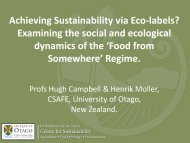Book of Abstract (incl. addendum) - IFSA symposium 2012
Book of Abstract (incl. addendum) - IFSA symposium 2012
Book of Abstract (incl. addendum) - IFSA symposium 2012
Create successful ePaper yourself
Turn your PDF publications into a flip-book with our unique Google optimized e-Paper software.
Workshop 5.2 European realities – assymetric rural development and revalorization <strong>of</strong><br />
marginal lands in Europe<br />
Multifunctional transition pathways: How are multi-stakeholder’s land<br />
management influencing farm systems resilience?<br />
Case study <strong>of</strong> Mediterranean agro-forestry systems in South Portugal<br />
Filipe Barroso, Helena Menezes and Teresa Pinto-Correia<br />
Èvora University, Portugal<br />
Flb@uevora.pt<br />
The changing role <strong>of</strong> agriculture is at the core <strong>of</strong> transition pathways in many rural areas. Productivism,<br />
post-productivism and multifunctionality have been targeted towards a possible conceptualization <strong>of</strong><br />
the transition happening in rural areas. The factors <strong>of</strong> change, <strong>incl</strong>uding productivist and postproductivist<br />
trends, are combined in various ways and have gone in quite diverse directions and<br />
intensities, in individual regions and localities. Even, in the same holding, productivist and postproductivist<br />
strategies can co-exist spatially, temporally, structurally, leading to a higher complexity in<br />
changing patterns. In south Portugal extensive landscapes, dominated by traditionally managed agr<strong>of</strong>orestry<br />
systems under a fuzzy land use pattern, multifunctionality at the farm level is indeed conducted<br />
by different stakeholders whose interests may or not converge: a multifunctional land management<br />
may indeed incorporate post-productivist and productivist agents. These stakeholders act under<br />
different levels <strong>of</strong> ownership, management and use, reflecting a particular land management dynamic,<br />
in which different interests may exist, from commercial production to a variety <strong>of</strong> other functions<br />
(hunting, bee-keeping, subsistence farming, etc.), influencing management at the farm level and its<br />
supposed transition trajectory. This multi-stakeholder dynamic is composed by the main land-manager<br />
(the one who takes the main decisions), sub land-managers (land-managers under the rules <strong>of</strong> the main<br />
land-manager), workers and users (locals or outsiders), whose interest and action within the holding<br />
may vary differently according to future (policy, market, etc.) trends, and therefore reflect more or less<br />
resilient systems. The goal <strong>of</strong> the proposed presentation is to describe a multi-stakeholder relations<br />
model at the farm level, its spatial expression and the factors influencing the land management system<br />
resilience in face <strong>of</strong> the transition trends in place.<br />
The Role <strong>of</strong> Minor Crops in the Valorisation <strong>of</strong> Marginal Rural Areas: the<br />
case <strong>of</strong> Iris Pallida<br />
Silvia Scaramuzzi, Enrica Fani, Andrea Marescotti and Giovanni Belletti<br />
University <strong>of</strong> Florence, Italy<br />
Silvia.Scaramuzzi@unifi.it<br />
Nowadays the problem <strong>of</strong> valorization <strong>of</strong> marginal rural areas in Europe is significant. In Italy, despite<br />
the wide globalization that has developed in the agro-industrial system, some traditional agricultural<br />
crops with high added value may play an important role for the environmental preservation and social<br />
and economic development <strong>of</strong> some marginal rural areas.<br />
The purpose <strong>of</strong> this paper is to analyse the potential role and limits <strong>of</strong> minor crops in the<br />
valorisation <strong>of</strong> marginal rural areas. The paper presents a case study analysis on the Iris Pallida supply<br />
chain. Iris Pallida is a minor crop, whose rhizome is used by the international fragrances industry. The<br />
cultivation is limited to only two subregions in Tuscany (Chianti and Pratomagno), in very remote<br />
areas and it is usually complementary to the olive oil production.<br />
The field work carried out at local, national and international level has allowed to describe in<br />
detail the local production system, the threats to its survival, and the opportunities <strong>of</strong> its valorization<br />
thanks to its connections to the global market and the high interest <strong>of</strong> the local stakeholders in<br />
supporting it for its high potential to revalorize and environmentally protect some rural areas that are<br />
now abandoned.<br />
A development <strong>of</strong> the cultivation could answer also to an increasing request <strong>of</strong> the rhizome from<br />
French fragrances industry, due to its outstanding quality attributes.<br />
92











